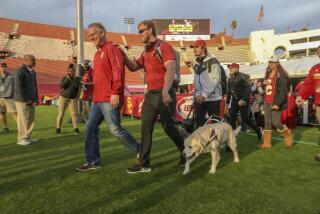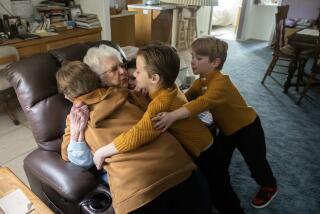4-H Members Rear Future Guide Dogs : Young Hands Train ‘Eyes’ for the Blind
- Share via
ROLLING HILLS ESTATES — Trevor and Trent Lattin, like most other youngsters in 4-H Clubs, know they shouldn’t get too close to their animals. The day will come when they must give them up.
That may not be so hard if the animal is a calf. When it’s a guide-dog puppy, the emotional bonds may be tougher to break.
Trevor, 14, and his brother Trent, 12, have been raising guide-dog puppies as a 4-H project for almost two years. Trevor is one of the leaders of a group of Palos Verdes Peninsula youngsters raising 13 dogs that will become eyes for the blind.
“I’d say it’s the hardest thing I’ve ever had to do,” Trevor said, recalling the day last year when he had to give up Georgia, his first guide dog. “But it’s all worthwhile because you’ve put all your efforts into training the dog--it’s been your constant companion for over a year.”
Adapted to City
Because raising cattle is not a practical project for a South Bay youngster, the 4-H, normally associated with teaching animal husbandry and agriculture in the Midwest, has adapted its program to teach leadership and citizenship to the children of city slickers.
A 4-H spokeswoman said there are two chapters on the Peninsula--Rolling Hills Estates and Palos Verdes Estates--and they have programs in such non-agricultural areas as science, hiking and photography as well as the more traditional fields of horse and rabbit care.
The national organization, founded in 1905, is sponsored by the U.S. Department of Agriculture. Its aim is to improve the “head, hands, heart and health” of its 4.3 million youngsters.
“Only 16% of our members live in a rural area,” said Denise Miller of the National 4-H Council. “So where we originally taught how to tend crops or raise livestock, today we teach them things more appropriate for an urban area, like gardening or raising dogs.
“The thing that’s good about the guide-dog program is that it gets the members involved in community service, which we stress; plus there is the animal-and-child connection,” Miller said.
Trent has been in charge of Gina, a yellow Labrador retriever, for six months. Trevor and his second dog, Tabetha, a golden retriever, have been together for 11 months, and the day is rapidly approaching when she will return to Guide Dogs for the Blind, a nonprofit organization in the San Francisco Bay area.
The group gives a dog to the 4-H members when it is 8 to 10 weeks old. For 12 to 15 months the youngsters work with the animal on house manners, socialization and some of the basic disciplines it will later use on the job.
Intensive Training
Geri Owens, a spokeswoman for Guide Dogs for the Blind at its San Rafael school, said her group places about 500 dogs in training homes a year. Only about 250 pass both the 4-H training and the intensive 28-day course each dog is put through with its new blind owner, she said.
The trained dog, which the school values at $10,000, and the 28-day course are given free to the blind.
The training is not easy for the dogs, the trainers or their families, Owens emphasized.
“Remember, there are bad points about raising any puppy,” she said. “These are happy, normal puppies. They are not housebroken. They are teething, so everything they can get their mouths on is fair game. Because the dog has guide-dog breeding, people get the romantic notion that all they are going to have to do is babysit the dog for a year. But you have to train the dog so that he’s well behaved when he’s in the mall and when he’s traveling.
“The dog can’t be flying around at the end of the leash.”
Walks Have Purpose
Trent said he and his brother walk their dogs at least twice a day. This week he was working with Gina to get her to walk with her head up and not constantly sniff the ground.
“It’s OK if she sniffs once in a while, but not all the time,” he said.
As he walked with her along a neighborhood street, a stray dog bolted into their path. Gina wanted to go play with it, but Trent kept her with him by a series of short, sharp jerks on her leash.
“But not hard enough to hurt her,” he said.
Tabetha had been having trouble adjusting to traffic, so Trevor took her to Palos Verdes Drive North, where he had her sit and watch the rush hour while he stroked and praised her to make her comfortable.
“She’s a little skittish,” Trevor said. “But she has the perfect disposition for a guide dog. A little more exposure (to traffic) and that should do the trick.”
No Pain Allowed
Both Trevor and Trent said no physically painful punishment is permitted, nor is food used as a reward. The only training devices allowed are praise and firmness.
One of the hardest things to teach the dogs is that they cannot relieve themselves while in their training jackets, which is used to get the dogs ready for a harness. Dogs must learn not to stop at will when they are in harness.
As much as they would like to, the boys cannot be with the dogs 24 hours a day, nor can they afford the expense of raising the pups. That’s where their parents, Kenneth and Sue Lattin, come in.
‘A Family Project’
“This is really a family project,” Sue Lattin said. “When the boys are home, the dogs are their total responsibility. But when the boys are in school, guess who’s in charge.” She said she often takes one of the dogs with her on errands while Trevor, a freshman, is at Rolling Hills High School and Trent, a seventh-grader, is at Malaga Cove Intermediate School.
Kenneth Lattin, an investment real estate salesman, is using some of his business contacts to find more stores that will allow training on their premises. In a recent resolution commending the 4-H project, the Rolling Hills Estates City Council urged businesses to let the dogs in.
Under state law, a blind person with a guide dog must be permitted into any establishment. That is not the case with guide dog puppies.
“If they let us in, it’s as a favor to us,” Owens said.
She said puppy raisers are usually recruited by someone already in the project.
Neighbor Raised Dogs
The Lattins became involved in 4-H and the project through a neighbor who raised guide dogs and has since gone away to college. Trent had a small dog, Marly, and Trevor wanted a dog of his own.
Most guide dog families already own dogs, Owens said, and that helps relieve the hurt of giving the guide dogs back.
“When Trevor said he wanted a dog, it was a family decision to get a big dog, a golden retriever,” his father said. Then the Lattins learned about the 4-H project. They were offered the choice of training a guide dog or taking care of a female used for breeding purposes.
“(The latter) didn’t sound like such a great idea,” Ken Lattin said.
Second Thoughts
For the first few weeks with Georgia, he said, the family wondered if they had made the right decision.
“She was four months old when she came to us, which is a little bit older than normal, and she was already somewhat set in her ways,” Ken Lattin said.
Georgia eventually made it to San Rafael, but she had to be dropped from the program when she and her prospective owner didn’t get along.
“It was a blow to us,” Ken Lattin said. “We were so thrilled when she went to the school.”
His wife said that it was like sending a child to college.
“I was calling up the school every week and asking them what kind of grades she was getting,” Sue Lattin said.
Rejects Offered Back
A prospective guide dog that flunks out of the program is first offered as a pet to the family that trained it. If they can’t take it--as was the case with Georgia--it is put up for adoption. Georgia was taken by a family in Manhattan Beach. There is a five-year waiting list for these dogs.
“That’s because their training’s so good,” Trent said.
Owens said blind people come to their program through the advice of a doctor or their mobility instructor.
“There is quite a bit of paperwork involved, including personal references,” Owens said. “An instructor then visits the blind person to see if he or she will benefit from a dog. Some aren’t coordinated enough for a dog. Some don’t have enough of a sense of mobility. They say, ‘But that’s why I want a dog,’ but to use a dog you have to be acclimated to your area.”
Despite the occasional setbacks and the heartbreak of knowing you have to give up the dogs, Ken Lattin said he and his family have no regrets about being a part of the program.
“It’s been good for the kids, good for the family and, hopefully, good for the dogs,” he said.
More to Read
Sign up for Essential California
The most important California stories and recommendations in your inbox every morning.
You may occasionally receive promotional content from the Los Angeles Times.













